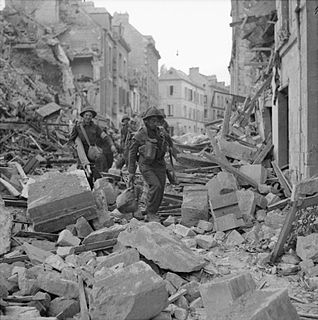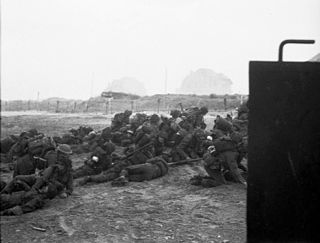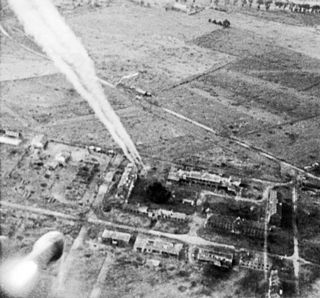 W
WThe Battle for Caen is the name given to fighting between the British Second Army and the German Panzergruppe West in the Second World War for control of the city of Caen and vicinity, during the larger Battle of Normandy. The battles followed Operation Neptune, the Allied landings on the French coast on 6 June 1944 (D-Day). Caen is about 9 mi (14 km) inland from the Calvados coast astride the Orne River and Caen Canal, at the junction of several roads and railways. The communication links made it an important operational objective for both sides. Caen and the area to the south is flatter and more open than the bocage country in western Normandy; Allied air force commanders wanted the area captured quickly to base more aircraft in France.
 W
WOperation Atlantic was a Canadian offensive during the Battle of Normandy in the Second World War. The offensive, launched in conjunction with Operation Goodwood by the Second Army, was part of operations to seize the French city of Caen and vicinity from German forces. It was initially successful, with gains made on the flanks of the Orne River near Saint-André-sur-Orne but an attack by the 4th and 6th Canadian Infantry Brigades of the 2nd Canadian Infantry Division, against strongly defended German positions on Verrières Ridge to the south was a costly failure.
 W
WOperation Charnwood was an Anglo-Canadian offensive that took place from 8 to 9 July 1944, during the Battle for Caen, part of the larger Operation Overlord in the Second World War. The operation was intended to capture the German-occupied city of Caen, which was an important objective for the Allies during the opening stages of Overlord. It was also hoped that the attack would forestall the transfer of German armoured units from the Anglo-Canadian sector to the American sector to the west, where an offensive was being prepared. The British and Canadians advanced on a broad front and by the evening of the second day had taken Caen up to the Orne and Odon rivers.
 W
WOperation Epsom, also known as the First Battle of the Odon, was a British offensive in the Second World War between 26 and 30 June 1944, during the Battle of Normandy. The offensive was intended to outflank and seize the German-occupied city of Caen, an important Allied objective, in the early stages of Operation Overlord, the Allied invasion of north-west Europe.
 W
WOperation Goodwood was a British offensive in the Second World War, that took place between 18 and 20 July 1944 as part of the battle for Caen in Normandy, France. The objective of the operation was a limited attack to the south, from the Orne bridgehead, to capture the rest of Caen and the Bourguébus Ridge beyond. At least one historian has called the operation the largest tank battle that the British Army has ever fought.
 W
WJuno or Juno Beach was one of five beaches of the Allied invasion of German-occupied France in the Normandy landings on 6 June 1944 during the Second World War. The beach spanned from Courseulles, a village just east of the British beach Gold, to Saint-Aubin-sur-Mer, and just west of the British beach Sword. Taking Juno was the responsibility of the Canadian Army, with sea transport, mine sweeping, and a naval bombardment force provided by the Royal Canadian Navy and the British Royal Navy as well as elements from the Free French, Norwegian, and other Allied navies. The objectives of the 3rd Canadian Infantry Division on D-Day were to cut the Caen-Bayeux road, seize the Carpiquet airport west of Caen, and form a link between the two British beaches on either flank.
 W
WOperation Jupiter was an offensive by VIII Corps of the British Second Army from 10 to 11 July 1944. The operation took place during the Battle of Normandy in the Second World War. The objective of the 43rd (Wessex) Infantry Division was to capture the villages of Baron-sur-Odon, Fontaine-Étoupefour, Chateau de Fontaine and to recapture Hill 112. An attached brigade of the 15th (Scottish) Infantry Division would take Éterville, Maltot and the ground up to the River Orne and then the tanks of the 4th Armoured Brigade, supported by infantry, would advance through the captured ground and secure several villages to the west of the River Orne. It was hoped that the initial objectives could be captured by 9:00 a.m., after which the 4th Armoured Brigade would exploit the success.
 W
WThe RAF raid on La Caine (1944) was an attack in Normandy by the Second Tactical Air Force of the Royal Air Force (RAF) on 10 June 1944. The attack was made on the château at La Caine, about 12 mi (19 km) to the south-west of the city of Caen, north of Thury-Harcourt. The château had recently been occupied by Panzergruppe West, the command organisation for the German Panzer divisions in France and Belgium.
 W
WOperation Martlet was part of a series of British attacks to capture the French town of Caen and its environs from German forces during the Battle of Normandy of World War II begun by the Allies. It was a preliminary operation undertaken on 25 June 1944 by XXX Corps of the British Second Army, to capture Rauray and the area around Noyers. The attack was to protect the right flank of VIII Corps as it began Operation Epsom, an offensive into the Odon Valley west of Caen, on 26 June. The 50th (Northumbrian) Infantry Division and the 49th Infantry Division were to capture Juvigny-sur-Seulles, Vendes and Rauray, to prevent German counter-attacks against VIII Corps from the area of the Rauray Spur and then extend the attack towards Noyers and Aunay-sur-Odon. It was the first time in Normandy that the 49th Division operated as a division.
 W
WThe Battle of Le Mesnil-Patry during the Second World War, was the last attack by an armoured battle group conducted by Canadian troops in Normandy in June 1944. The Queen's Own Rifles of Canada of the 8th Canadian Infantry Brigade of the 3rd Canadian Division, supported by the 6th Armoured Regiment of the 2nd Canadian Armoured Brigade attacked the village of Le Mesnil-Patry in Normandy, to advance southwards towards the higher ground of Hill 107 to the west of Cheux. The attack was intended to support a larger operation by the 50th (Northumbrian) Infantry Division and the 7th Armoured Division to capture the city of Caen and to advance in the centre of the bridgehead next to the First US Army. The battle was a German defensive success but the greater German objective of defeating the invasion by a counter-offensive also failed.
 W
WThe Normandy landings were the landing operations and associated airborne operations on Tuesday, 6 June 1944 of the Allied invasion of Normandy in Operation Overlord during World War II. Codenamed Operation Neptune and often referred to as D-Day, it was the largest seaborne invasion in history. The operation began the liberation of France and laid the foundations of the Allied victory on the Western Front.
 W
WThe Second Battle of the Odon comprised operations fought by the British Second Army during the Second World War Attacks took place in mid-July 1944 against Panzergruppe West as part of the Battle of Normandy. Operations Greenline and Pomegranate were intended to draw German attention away from Operation Goodwood, an attack from the Orne bridgehead on 18 July.
 W
WOperation Perch was a British offensive of the Second World War which took place from 7 to 14 June 1944, during the early stages of the Battle of Normandy. The operation was intended to encircle and seize the German occupied city of Caen, which was a D-Day objective for the British 3rd Infantry Division in the early phases of Operation Overlord. Operation Perch was to begin immediately after the British beach landings with an advance to the south-east of Caen by XXX Corps. Three days after the invasion the city was still in German hands and the operation was amended. The operation was expanded to include I Corps for a pincer attack on Caen.
 W
WSword, commonly known as Sword Beach, was the code name given to one of the five main landing areas along the Normandy coast during the initial assault phase, Operation Neptune, of Operation Overlord, the Allied invasion of German-occupied France that commenced on 6 June 1944. Stretching 8 kilometres (5.0 mi) from Ouistreham to Saint-Aubin-sur-Mer, the beach proved to be the easternmost landing site of the invasion after the abortion of an attack on a sixth beach, code-named Band. Taking Sword was to be the responsibility of the British Army with sea transport, mine sweeping, and a naval bombardment force provided by the British Royal Navy as well as elements from the Polish, Norwegian and other Allied navies.
 W
WThe Battle of Villers-Bocage took place during the Second World War on 13 June 1944, one week after the Normandy Landings, which had begun the Western Allies' conquest of German-occupied France. The battle was the result of a British attempt to improve their position by exploiting a gap in the German defences west of the city of Caen. After one day of fighting in and around the small town of Villers-Bocage and a second day defending a position outside the town, the British force retreated.
 W
WOperation Windsor (4–5 July 1944), was a Canadian attack, which was part of the Battle of Normandy during the Second World War. The attack was undertaken by the 3rd Canadian Infantry Division to take Carpiquet and the adjacent airfield, from troops of the 12th SS-Panzer Division Hitler Jugend of Panzergruppe West. The attack was originally intended to take place during the later stages of Operation Epsom, to protect the eastern flank of the main assault but was postponed for a week.
 W
W W
W W
W